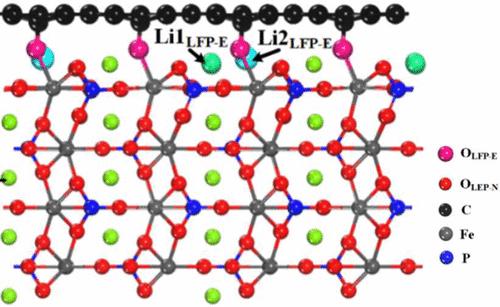当前位置:
X-MOL 学术
›
Nano Lett.
›
论文详情
Our official English website, www.x-mol.net, welcomes your
feedback! (Note: you will need to create a separate account there.)
Excess Li-Ion Storage on Reconstructed Surfaces of Nanocrystals To Boost Battery Performance
Nano Letters ( IF 9.6 ) Pub Date : 2017-09-20 00:00:00 , DOI: 10.1021/acs.nanolett.7b02315 Yandong Duan 1 , Bingkai Zhang 1 , Jiaxin Zheng 1 , Jiangtao Hu 1 , Jianguo Wen , Dean J. Miller , Pengfei Yan 2 , Tongchao Liu 1 , Hua Guo 1 , Wen Li 1 , Xiaohe Song 1 , Zengqing Zhuo 1 , Chaokun Liu 1 , Hanting Tang 1 , Rui Tan 1 , Zonghai Chen , Yang Ren , Yuan Lin 1 , Wanli Yang , Chong-Min Wang 2 , Lin-Wang Wang , Jun Lu , Khalil Amine , Feng Pan 1
Nano Letters ( IF 9.6 ) Pub Date : 2017-09-20 00:00:00 , DOI: 10.1021/acs.nanolett.7b02315 Yandong Duan 1 , Bingkai Zhang 1 , Jiaxin Zheng 1 , Jiangtao Hu 1 , Jianguo Wen , Dean J. Miller , Pengfei Yan 2 , Tongchao Liu 1 , Hua Guo 1 , Wen Li 1 , Xiaohe Song 1 , Zengqing Zhuo 1 , Chaokun Liu 1 , Hanting Tang 1 , Rui Tan 1 , Zonghai Chen , Yang Ren , Yuan Lin 1 , Wanli Yang , Chong-Min Wang 2 , Lin-Wang Wang , Jun Lu , Khalil Amine , Feng Pan 1
Affiliation

|
Because of their enhanced kinetic properties, nanocrystallites have received much attention as potential electrode materials for energy storage. However, because of the large specific surface areas of nanocrystallites, they usually suffer from decreased energy density, cycling stability, and effective electrode capacity. In this work, we report a size-dependent excess capacity beyond theoretical value (170 mA h g–1) by introducing extra lithium storage at the reconstructed surface in nanosized LiFePO4 (LFP) cathode materials (186 and 207 mA h g–1 in samples with mean particle sizes of 83 and 42 nm, respectively). Moreover, this LFP composite also shows excellent cycling stability and high rate performance. Our multimodal experimental characterizations and ab initio calculations reveal that the surface extra lithium storage is mainly attributed to the charge passivation of Fe by the surface C–O–Fe bonds, which can enhance binding energy for surface lithium by compensating surface Fe truncated symmetry to create two types of extra positions for Li-ion storage at the reconstructed surfaces. Such surface reconstruction nanotechnology for excess Li-ion storage makes full use of the large specific surface area of the nanocrystallites, which can maintain the fast Li-ion transport and greatly enhance the capacity. This discovery and nanotechnology can be used for the design of high-capacity and efficient lithium ion batteries.
中文翻译:

锂离子在纳米晶体重构表面上的过多存储可提高电池性能
由于其增强的动力学性质,作为能量存储的潜在电极材料,纳米微晶受到了广泛的关注。然而,由于纳米微晶的大比表面积,它们通常遭受能量密度,循环稳定性和有效电极容量降低的困扰。在这项工作中,我们通过在纳米LiFePO 4(LFP)正极材料(186和207 mA hg –1)的重建表面引入额外的锂存储,报告了超出理论值(170 mA hg –1)的尺寸相关的过剩容量。在平均粒径分别为83和42 nm的样品中)。此外,该LFP复合材料还显示出出色的循环稳定性和高倍率性能。我们的多峰实验表征和从头算的计算表明,表面多余的锂存储主要归因于表面C–O–Fe键对Fe的电荷钝化,这可以通过补偿表面Fe截断的对称性来增强表面锂的结合能,从而产生锂离子在重构表面存储的两种额外位置。这种用于过量锂离子存储的表面重构纳米技术充分利用了纳米微晶的大比表面积,可以维持锂离子的快速传输并大大提高了容量。
更新日期:2017-09-20
中文翻译:

锂离子在纳米晶体重构表面上的过多存储可提高电池性能
由于其增强的动力学性质,作为能量存储的潜在电极材料,纳米微晶受到了广泛的关注。然而,由于纳米微晶的大比表面积,它们通常遭受能量密度,循环稳定性和有效电极容量降低的困扰。在这项工作中,我们通过在纳米LiFePO 4(LFP)正极材料(186和207 mA hg –1)的重建表面引入额外的锂存储,报告了超出理论值(170 mA hg –1)的尺寸相关的过剩容量。在平均粒径分别为83和42 nm的样品中)。此外,该LFP复合材料还显示出出色的循环稳定性和高倍率性能。我们的多峰实验表征和从头算的计算表明,表面多余的锂存储主要归因于表面C–O–Fe键对Fe的电荷钝化,这可以通过补偿表面Fe截断的对称性来增强表面锂的结合能,从而产生锂离子在重构表面存储的两种额外位置。这种用于过量锂离子存储的表面重构纳米技术充分利用了纳米微晶的大比表面积,可以维持锂离子的快速传输并大大提高了容量。











































 京公网安备 11010802027423号
京公网安备 11010802027423号